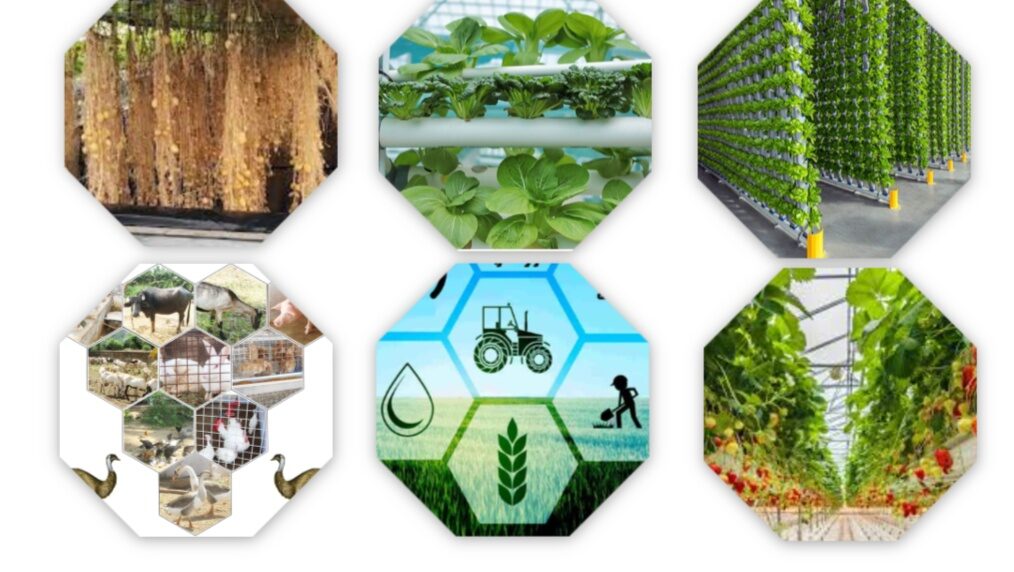
There are many different ways through modern farming methods to grow food besides the traditional method of planting in soil:
- Hydroponic Farming: Instead of using soil, plants are grown in nutrient-rich water. This allows for precise control over the nutrients the plants receive, and it’s often used for growing things like vegetables and herbs.
- Aeroponic Farming: In this method, the plant’s roots are misted with a nutrient solution while being suspended in the air. This provides excellent aeration and nutrient delivery to the plants.
- Aquaponic Farming: Aquaponics combines fish farming with hydroponics. Plants are grown in water enriched with nutrients from fish waste, creating a mutually beneficial relationship between the plants and fish.
- Vertical Farming: Crops are grown in stacked layers or on vertically inclined surfaces, usually in controlled indoor environments. This maximizes space and resource efficiency.
- Organic Farming: Organic farming focuses on using natural and environmentally friendly practices, avoiding synthetic chemicals, pesticides, and GMOs. It also employs sustainable techniques to maintain soil health and reduce the impact on the environment.
- Permaculture: This is a holistic and sustainable approach to farming that mimics natural ecosystems and patterns. It emphasizes diverse and integrated farming systems, regenerative practices, and reducing waste.
- Precision Farming: Also known as precision agriculture or smart farming, this method uses technology like GPS, sensors, and data analytics to optimize farming operations. It helps farmers make data-driven decisions to improve crop yield and reduce resource wastage.
- No-Till Farming: This approach minimizes soil disturbance and erosion by avoiding plowing or tilling. It helps maintain soil structure and moisture while reducing the need for synthetic chemicals.
- Urban Farming: Urban farming involves growing crops and raising animals in cities and urban areas. This can include rooftop gardens, community gardens, or even hydroponic systems in unused urban spaces.
- Regenerative Agriculture: This method focuses on building healthy and resilient ecosystems by enhancing soil health and sequestering carbon. It uses practices like cover cropping, crop rotation, and reducing chemical usage.
Each of these methods of farming has its own unique advantages and challenges. Farmers often choose the method that best suits their specific agricultural needs and goals. These innovative approaches to farming are helping to address the growing demand for food in a more sustainable and efficient way.
मिट्टी में रोपण की पारंपरिक विधि के अलावा खाने योग्य चीजें उगाने के कई अलग-अलग तरीके हैं। आइए इनमें से कुछ तरीकों पर एक नज़र डालें:
1) हाइड्रोपोनिक खेती: मिट्टी का उपयोग करने के बजाय, पौधों को पोषक तत्वों से भरपूर पानी में उगाया जाता है। यह पौधों को प्राप्त होने वाले पोषक तत्वों पर सटीक नियंत्रण की अनुमति देता है, और इसका उपयोग अक्सर सब्जियों और जड़ी-बूटियों जैसी चीजों को उगाने के लिए किया जाता है।
2) एरोपोनिक खेती: इस विधि में, हवा में लटकते समय पौधे की जड़ों को पोषक तत्व के घोल से धोया जाता है। यह पौधों को उत्कृष्ट वातन और पोषक तत्व प्रदान करता है।
3) एक्वापोनिक खेती: एक्वापोनिक्स मछली पालन को हाइड्रोपोनिक्स के साथ जोड़ती है। पौधों को मछली के अपशिष्ट से पोषक तत्वों से समृद्ध पानी में उगाया जाता है, जिससे पौधों और मछली के बीच पारस्परिक रूप से लाभप्रद संबंध बनता है।
4) ऊर्ध्वाधर खेती: फसलें खड़ी परतों में या लंबवत झुकी हुई सतहों पर उगाई जाती हैं, आमतौर पर नियंत्रित इनडोर वातावरण में। यह स्थान और संसाधन दक्षता को अधिकतम करता है।
5) जैविक खेती: जैविक खेती सिंथेटिक रसायनों, कीटनाशकों और जीएमओ से परहेज करते हुए प्राकृतिक और पर्यावरण के अनुकूल प्रथाओं का उपयोग करने पर केंद्रित है। यह मिट्टी के स्वास्थ्य को बनाए रखने और पर्यावरण पर प्रभाव को कम करने के लिए टिकाऊ तकनीकों का भी उपयोग करता है।
6) पर्माकल्चर: यह खेती के लिए एक समग्र और टिकाऊ दृष्टिकोण है जो प्राकृतिक पारिस्थितिकी तंत्र और पैटर्न की नकल करता है। यह विविध और एकीकृत कृषि प्रणालियों, पुनर्योजी प्रथाओं और अपशिष्ट को कम करने पर जोर देता है।
7) सटीक खेती: इसे सटीक कृषि या स्मार्ट खेती के रूप में भी जाना जाता है, यह विधि कृषि कार्यों को अनुकूलित करने के लिए जीपीएस, सेंसर और डेटा एनालिटिक्स जैसी तकनीक का उपयोग करती है। यह किसानों को फसल की पैदावार में सुधार और संसाधन की बर्बादी को कम करने के लिए डेटा-संचालित निर्णय लेने में मदद करता है।
8) बिना जुताई की खेती: यह दृष्टिकोण जुताई या जुताई से बचकर मिट्टी की गड़बड़ी और कटाव को कम करता है। यह सिंथेटिक रसायनों की आवश्यकता को कम करते हुए मिट्टी की संरचना और नमी को बनाए रखने में मदद करता है।
9) शहरी खेती: शहरी खेती में शहरों और शहरी क्षेत्रों में फसलें उगाना और जानवरों को पालना शामिल है। इसमें छत पर उद्यान, सामुदायिक उद्यान, या अप्रयुक्त शहरी स्थानों में हाइड्रोपोनिक सिस्टम भी शामिल हो सकते हैं।
10) पुनर्योजी कृषि: यह विधि मिट्टी के स्वास्थ्य को बढ़ाकर और कार्बन को अलग करके स्वस्थ और लचीले पारिस्थितिकी तंत्र के निर्माण पर केंद्रित है। यह कवर क्रॉपिंग, फसल चक्रण और रासायनिक उपयोग को कम करने जैसी प्रथाओं का उपयोग करता है।
इनमें से प्रत्येक विधि के अपने अनूठे फायदे और चुनौतियाँ हैं। किसान अक्सर वह तरीका चुनते हैं जो उनकी विशिष्ट कृषि आवश्यकताओं और लक्ष्यों के लिए सबसे उपयुक्त हो। खेती के ये नवीन दृष्टिकोण भोजन की बढ़ती मांग को अधिक टिकाऊ और कुशल तरीके से पूरा करने में मदद कर रहे हैं।
